Revolutionizing Healthcare Organizations with Data Visualization
What if the right people in your organization had the information needed to decrease patient wait times by finding the root causes of those unnecessarily long wait times? What if patient care team could find out what the primary drivers of high readmission rates for certain demographics of your patients? What if your supply chain experts could easily analyze spending, coordinate purchases and optimize expenditures across the healthcare system to reduce overall costs? This is all possible with healthcare data visualization. It puts the power of advanced data analytics into the hands of your people to see and understand the data quickly, improving the quality of decisions and increasing the speed of decisions.
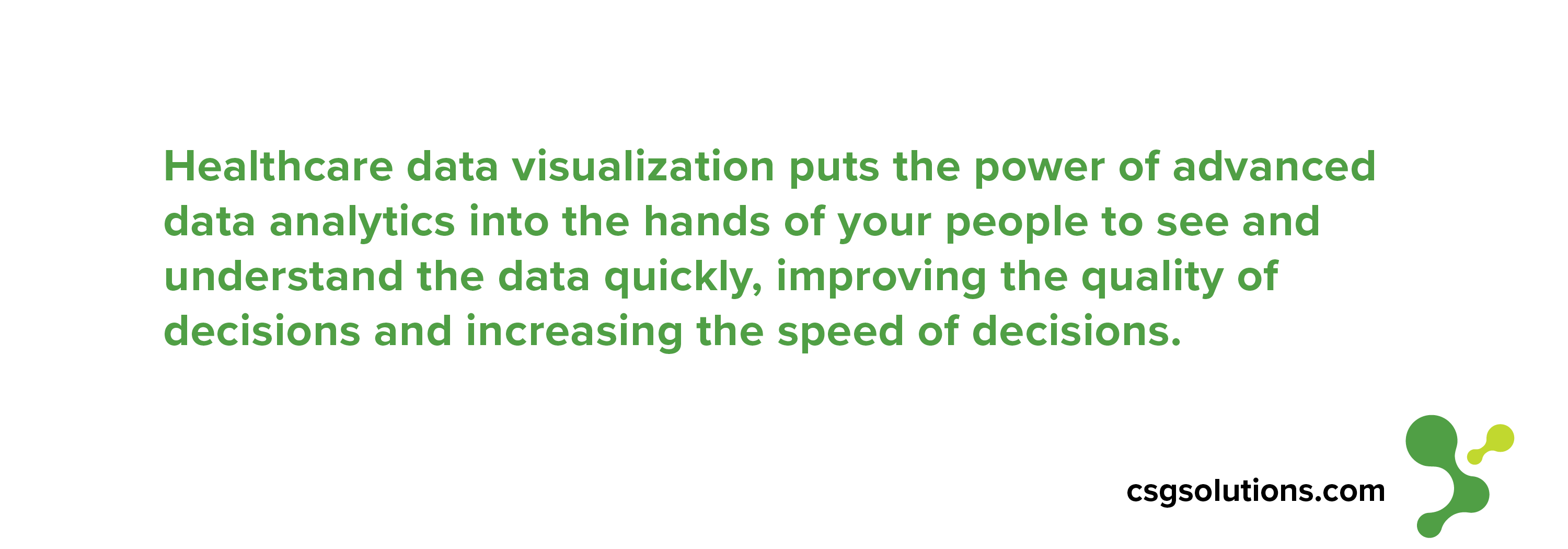
Healthcare organizations use data visualization to improve patient care, optimize financial management, improve operational efficiency and processes, and so much more. The International Data Corporation (IDC) projects that big data will grow faster in healthcare than in sectors like manufacturing, financial services, or media, and they also estimate that healthcare data will experience a compound annual growth rate of 36 percent through 2025. With that growth rate comes the need for the increased use of data visualization throughout healthcare organizations in order to bring clarity and focus to the abundance of data.
To say that healthcare organizations have many sources of data to sift through is an understatement. With data available through patient care and billing management systems, governmental population health data, electronic patient health records, value-based purchasing reports in Medicare and Medicaid databases, and National Institute of Health resources, healthcare organizations have more options for accessing data than ever before. As a result, they are increasing their efforts to unify their data and make it accessible for quick and easy use; the number one most effective way to make use of all of this data is to democratize it – to provide access to the data and data visualization tools to maximize the impact of this information on the healthcare organization.
Data visualization tools allow anyone to digest data quickly and easily by providing intuitive drag-and-drop tools to create charts, graphs, and visual plots from data that can be easily understood. Healthcare data visualizations significantly reduce the time it takes to gain insight from data. No longer is analysis the domain of advanced data scientists (although they can still play an important role). Data visualization tools enable people at all levels of the organization to easily spot trends and patterns, getting to the most important and applicable data more quickly. (To learn more about using data visualization tools, read our complete guide to data visualization tools for business owners.)
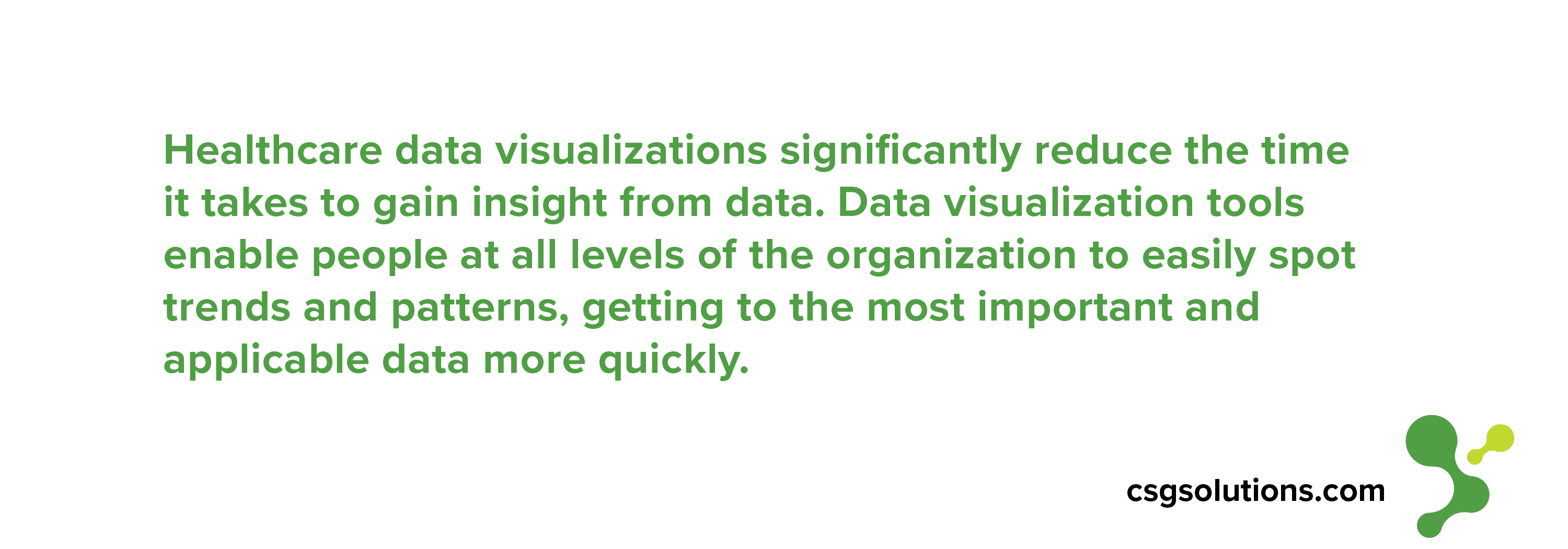
Data visualization solves the problem of how to report on so many things simply. With an abundance of data comes the challenge of exploring that data in a way that can quickly improve individual and organizational decision-making. Healthcare data visualization speeds up the analysis process by making the data easily accessible and communicates the results of analysis and key takeaways from the data succinctly to stakeholders across the organization. The bottom line: data visualization effectively motivates action in response to the data, instead of potentially losing the message of the data in many complex spreadsheets that are difficult to interpret.
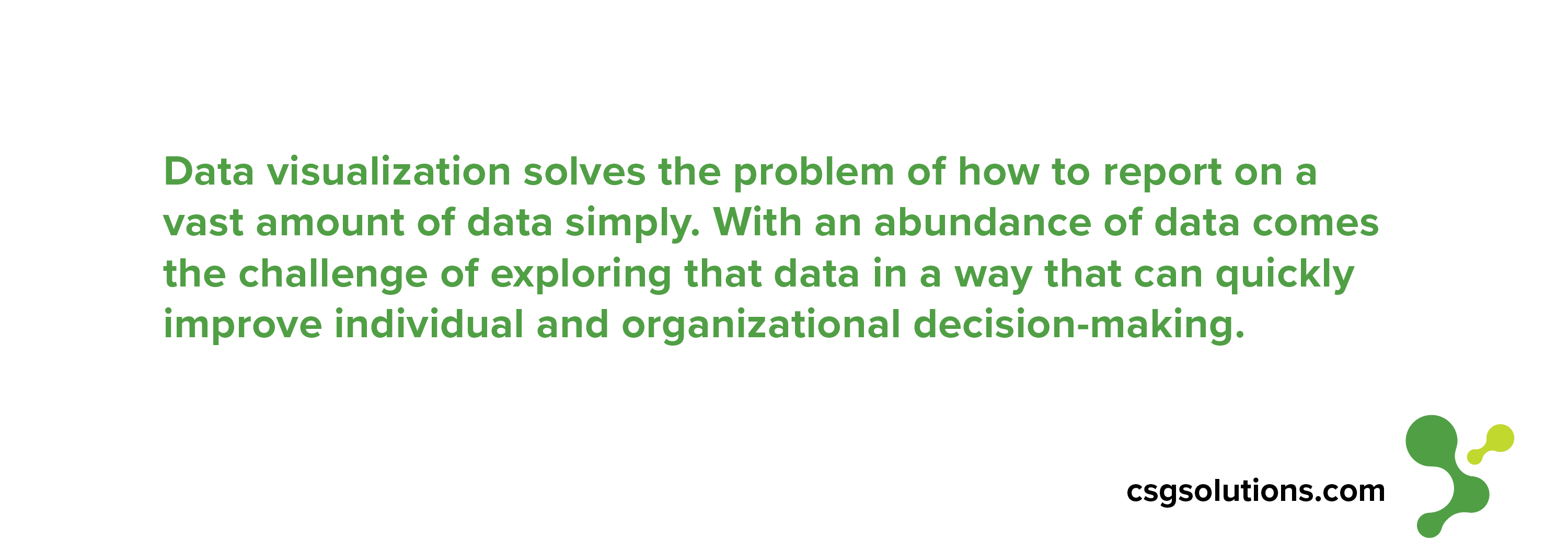
With data visualization, healthcare organizations dive deeper into the data and function more decisively than ever before. Read on for more as we explore how healthcare data visualization revolutionizes patient care, provider data access, financial management, and operational efficiency. We’ll also dive into how data visualization can specifically help healthcare providers meet important value-based care requirements.
Revolutionizing Patient Care with Healthcare Data Visualization
Healthcare data visualization significantly improves how healthcare providers serve their populations from the moment a patient walks in the door to the time they’re seen by a provider. Interactive data visualization dashboards that share up-to-date data (according to government standards and privacy policies) equip healthcare providers to consistently improve patient outcomes and experiences.
Here are a few specific ways that healthcare data visualization is used regularly to improve patient care:
- Guiding initiatives aimed at improving the quality of care and measuring key indicators of improvement
- Understanding who receives care and how, where, and when certain patient populations interact with providers
- Assessing and improving patient wait times (Consider how crucial this could be in the ER, where every moment counts)
- Visualizing genomic and clinical data to track infections in hospitals and modeling future scenarios to avoid the spread of infection
- Assessing readmission rates and forecasting readmissions by looking at discharges and readmissions by date, by person and by type of visit (wellness visit, emergency visit, etc.)
- Optimizing the efficiency of the new patient process, improving patient experiences and saving time
Improving Provider Data Access with Healthcare Data Visualization
All of these developments in patient care come with optimized access to data. Previous to using data visualization tools, healthcare providers may struggle to aggregate all the data they need and view it in a succinct format, let alone in a format where the data is visually easier to read and where they can quickly add new data sets for more detailed analysis.
Here are some key ways that data visualization tools improve data access for healthcare providers, ultimately improving patient care:
- Providing up-to-date, complete patient information for provider decision-making through the use of Electronic Health Records (EHR) and improved data collection. Providers use this information to improve care coordination and preventive health services (See our case study on this.)
- Quickly analyzing large sets of clinical data. reducing the time spent on data analysis. In one study, data visualization reduced electronic health data analysis time by 65% in the first year alone.
- Improving point of care data collection. This includes reducing time and resources waste by gathering the right information at the point-of-care (i.e. repeating a test because of incorrectly gathered information or because the test results were not successfully delivered to the specialist that needed it).
- Increasing possibilities for collaboration between providers, specialists, and staff by having the data on-hand and able to be trusted
- Presenting key insights from research quickly and compellingly, whether for publication or presentation to other healthcare providers and stakeholders
Financial Resource Assessment and Management with Data Visualization
In addition to improving patient care and healthcare providers’ access to data and analysis, data visualization is used in healthcare organizations to understand key areas of waste, optimize organization-wide spending on supplies and equipment, improve billing processes, and easily access regional performance.
With data visualization, your organization’s financial information is easily on-hand for analysis. (No more waiting for the quarterly report to come out to drive adjustments.) You can pivot processes, reallocate resources, and track your performance any time you need.
Here are more possibilities for using data visualization for healthcare organization financial management:
- Optimizing revenue cycle management
- Combining clinical data with financial data to support value-based purchasing models and assess correlations between certain types of care and billing/payment trends, with a focus on improving outcomes
- Assessing inventory inefficiencies such as: How often and for what reason are expensive special orders being made, which products could be replaced with cheaper equivalents, what percentage of inventory is in use, and are certain inventory items expiring or being wasted?
- Proving success to stakeholders by sharing performance data and data behind successful initiatives
- Reducing costs through more effective tracking and reporting of expenses and by unifying purchasing power across the organization (See our case study on this.)
- Aggregating and analyzing insurance payment data
- Understanding how different age groups/demographics access their payment information to optimize payment and billing processes for patients
Streamlining Organizational Operations and Management with Healthcare Data Visualization
Data visualization tools equip healthcare organizations to access information about their day-to-day business operations in real time - instead of waiting on weekly or monthly performance reports before making adjustments. Data visualization helps healthcare organizations access the data they need to measure their progress toward any and every operational goal or benchmark.
Here are more specific ways that healthcare organizations use data visualization for process improvement and efficiency:
- Assessing regional performance and identifying causes of underperformance in certain regions
- Modernizing reports, especially from legacy tools, allowing for quick, digital sharing of frequently accessed reports
- Improving information access and efficiency of analysis by unifying data from disparate sources across the organization, whether from operations, care quality, contracting, etc. (See our case study on how one healthcare organization save millions by establishing an automated single source of truth for their data.)
- Identifying new market opportunities
- Improving data veracity and trustworthiness with automation of data entry and with visualization tools. Increased data trust and accuracy leads to more people relying on the data to make decisions and choosing to access it on a regular basis.
- Reducing the likelihood of manual errors in reporting and data entry as well as the likelihood of redundant data. This comes from unifying your data sources and setting up consistent metrics for data collection.
- Communicating crucial research and data in a succinct way to key decision makers. Data visualization is proven to motivate action more effectively than spreadsheets or text-heavy presentations. Healthcare organizations can use visualizations to state the case for necessary systemic improvements and forecast results.
- Improving data governance. With data unified into a single repository for data visualization, data governance becomes much simpler. Data visualization tools like Tableau allow you to more easily control who has access to different datasets, and different levels of access can be established for increased privacy for sensitive information.
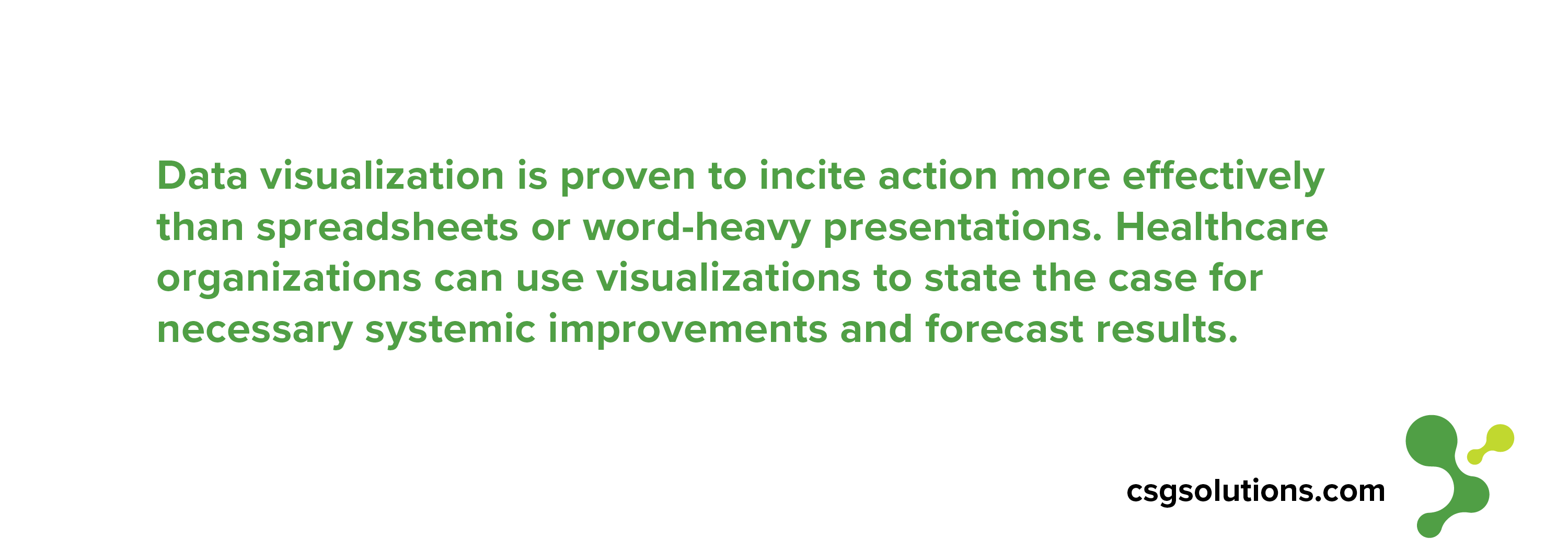
Meeting Value-Based Care Requirements with Healthcare Data Visualization
Especially with the introduction of value-based care and Medicare Advantage programs in 2016, having access to the right data is crucial for healthcare organizations to manage the quality of their care and their payment systems. According to Xtelligent Healthcare Media, organizations who want to successfully navigate value-based care will have to increase their focus on data analysis efforts:
“Unlike the traditional model, value-based care is driven by data because providers must report to payers on specific metrics and demonstrate improvement. Providers may have to track and report on hospital readmissions, adverse events, population health, patient engagement, and more. Under the new models, providers are incentivized to use evidence-based medicine, engage patients, upgrade health IT, and use data analytics in order to get paid for their services. When patients receive more coordinated, appropriate, and effective care, providers are rewarded.”
More than ever before it is the healthcare provider’s responsibility to advance the quality of care while also accounting for the cost of care for their patients - meaning that healthcare organizations must be able to access both financial and clinical data at once and draw correlations between them. For many organizations, this means an overhaul of their data storage and reporting processes, and data visualization moves to the forefront as one of a healthcare organization’s greatest assets. Having access to the right information at the right time is essential, and that’s where data visualization helps. Data visualization tools and improved data strategies equip healthcare organizations to meet value-based care benchmarks more efficiently and effectively, showing them exactly where there is room for improvement.
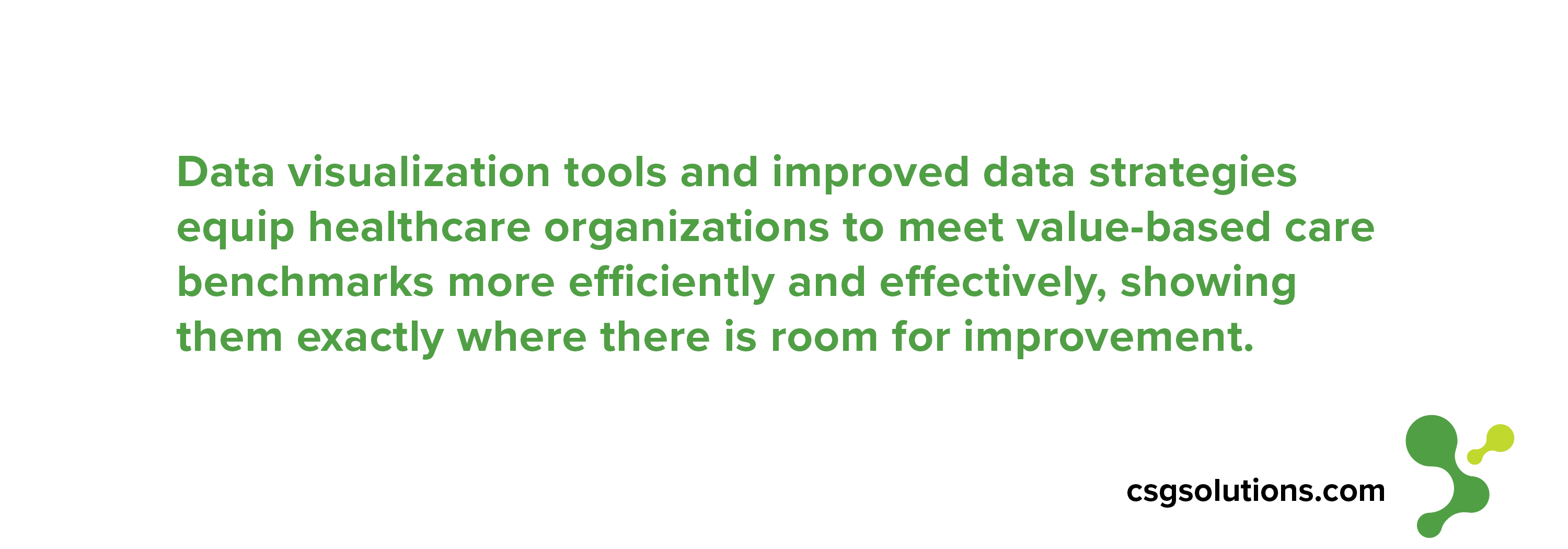
How One Healthcare Organization Improved Provider Performance Assessment with Data Visualization
In a world of value-based care where providers are rewarded and accountable for their quality of care, it is essential that providers have access to real-time performance data that affects their decision making and daily performance. Combining the necessary data sources can be a challenge and requires new reporting processes, data storage solutions, and, of course, effective data visualization tools that allow for easy access and interactivity with the data.
Recently a large healthcare organization came to CSG to build an interactive “provider scorecard” that combined reports from multiple departments and in multiple formats (excel spreadsheets, pdfs, and data from the organization’s healthcare software, etc.) into a single information source. They needed a new reporting system that had standardized metrics and that could be easily updated and viewed by physicians. The new system would allow physicians to understand how their performance stacks up against peers and would help managers regularly compare regional and individual provider performance.
With the introduction of a data visualization tool, Tableau, CSG equipped managers to view their data in two data visualization dashboards- a dashboard with a provider-centric view and one with a regional view. By separating the data into two possible views, the dashboards gave physicians access to their specific performance information and also gave managers access to additional regional performance data, focusing on only the data that would be actionable for each.
As a result of their new data visualization tool, reporting time for provider performance assessment decreased significantly. These reports were possible for the organization previously, but the new system made the data more accessible, set up consistent standards for data collection, and allowed for performance assessment at any time by physicians and managers.
Moving from printed reports to iPad and laptop access equipped managers to dive even deeper into the data during performance assessment meetings. Instead of waiting for the creation of a new report, managers and physicians can answer specific performance questions and explore possibilities for improvement on the spot, reducing the time between insight and action.
Physicians also gained the ability to view the data at any time they need and as a result could self-adjust, rather than having waiting on feedback from a manager or from a scheduled performance report. With the possibility for even minute adjustments to be made at any time by physicians and managers, the organization removed roadblocks to continuous provider improvement.

Lastly. because of the new system and metrics, the organization could start reporting on certain metrics with regularity for the very first time. An organized, central source for data collection with clear constraints and entry requirements allowed for clearer processes, improving the likelihood for consistency in data entry moving forward.
With the introduction of data visualization, providers and managers could more effectively use the vast amount of performance data already being collected, making adjustments as soon as they identified an area of improvement.
Data visualization allows for the exploration of complex data sets, but also ensures that the key takeaways from that data can be presented succinctly in order to insight action. If you’re ready to explore how healthcare data visualization can move your organization forward, #teamcsg would be glad to serve you. Get in touch using the form below, and we look forward to helping you dive deeper into your data.


